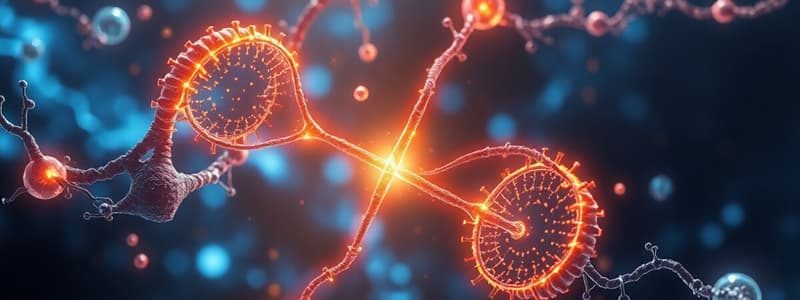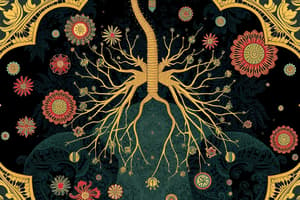Podcast
Questions and Answers
What is the energy requirement for the reaction ADP + Pi → ATP?
What is the energy requirement for the reaction ADP + Pi → ATP?
- +10.3 kcal/mol
- -7.3 kcal/mol
- +7.3 kcal/mol (correct)
- -3 kcal/mol
What type of reaction is ATP → ADP + Pi characterized as?
What type of reaction is ATP → ADP + Pi characterized as?
- Irreversible
- Reversible
- Exergonic (correct)
- Endergonic
What is the surplus energy released as heat when synthesizing ATP from creatine phosphate?
What is the surplus energy released as heat when synthesizing ATP from creatine phosphate?
- +10.3 kcal/mol
- -3 kcal/mol (correct)
- -10.3 kcal/mol
- +7.3 kcal/mol
What is the energy change associated with the reverse reaction of creatine to creatine phosphate?
What is the energy change associated with the reverse reaction of creatine to creatine phosphate?
What indicates that a reaction is exergonic?
What indicates that a reaction is exergonic?
How much energy is released when hydrolyzing creatine phosphate?
How much energy is released when hydrolyzing creatine phosphate?
Why is the energy free for the reaction creatine to creatine phosphate not sufficient to proceed?
Why is the energy free for the reaction creatine to creatine phosphate not sufficient to proceed?
What can be inferred about the high-energy phosphate bonds from the reactions described?
What can be inferred about the high-energy phosphate bonds from the reactions described?
What is the main purpose of oxidative phosphorylation?
What is the main purpose of oxidative phosphorylation?
Which complexes in the electron transport chain use energy to pump protons to the intermembrane space?
Which complexes in the electron transport chain use energy to pump protons to the intermembrane space?
How is the electrochemical potential (proton-motive force) created during oxidative phosphorylation?
How is the electrochemical potential (proton-motive force) created during oxidative phosphorylation?
Which of the following statements about the chemiosmotic coupling theory is true?
Which of the following statements about the chemiosmotic coupling theory is true?
Where do NADH and FADH2 primarily get produced in the context of oxidative phosphorylation?
Where do NADH and FADH2 primarily get produced in the context of oxidative phosphorylation?
What role does ATP synthase (Complex V) play in oxidative phosphorylation?
What role does ATP synthase (Complex V) play in oxidative phosphorylation?
Which complex is NOT involved in proton pumping during oxidative phosphorylation?
Which complex is NOT involved in proton pumping during oxidative phosphorylation?
What is the primary source of electrons for the electron transport chain?
What is the primary source of electrons for the electron transport chain?
What type of reaction is A → B described as?
What type of reaction is A → B described as?
What happens to the free energy when the reaction A → B occurs?
What happens to the free energy when the reaction A → B occurs?
What is the purpose of transforming energy from A → B into ATP?
What is the purpose of transforming energy from A → B into ATP?
What type of phosphorylation occurs when ADP is phosphorylated to form ATP using creatine phosphate?
What type of phosphorylation occurs when ADP is phosphorylated to form ATP using creatine phosphate?
What compound is formed when ADP is phosphorylated using the energy from creatine phosphate?
What compound is formed when ADP is phosphorylated using the energy from creatine phosphate?
What is the significance of the wavy bond (~) in high-energy compounds like ATP?
What is the significance of the wavy bond (~) in high-energy compounds like ATP?
Which enzyme is responsible for cleaving the high-energy phosphate bond in creatine phosphate?
Which enzyme is responsible for cleaving the high-energy phosphate bond in creatine phosphate?
What must occur for the endergonic reaction C → D to take place?
What must occur for the endergonic reaction C → D to take place?
What is the primary role of the malate-aspartate shuttle system?
What is the primary role of the malate-aspartate shuttle system?
Which electron carrier is primarily used in the malate-aspartate shuttle?
Which electron carrier is primarily used in the malate-aspartate shuttle?
Under what condition does the cell primarily enter state 3 or 5 during exercise?
Under what condition does the cell primarily enter state 3 or 5 during exercise?
What happens to oxaloacetate in the malate-aspartate shuttle?
What happens to oxaloacetate in the malate-aspartate shuttle?
What substance is generated when malate gives off electrons and protons in the matrix?
What substance is generated when malate gives off electrons and protons in the matrix?
Which state is associated with the availability of ADP only?
Which state is associated with the availability of ADP only?
Which shuttle system works alongside the creatine phosphate shuttle?
Which shuttle system works alongside the creatine phosphate shuttle?
What is the maximum yield of ATP produced through the malate-aspartate shuttle?
What is the maximum yield of ATP produced through the malate-aspartate shuttle?
What happens to molecular motion when solid water reaches absolute zero?
What happens to molecular motion when solid water reaches absolute zero?
Which statement best describes the first law of thermodynamics?
Which statement best describes the first law of thermodynamics?
What does the symbol ΔG represent in thermodynamics?
What does the symbol ΔG represent in thermodynamics?
In the equation ΔG = ΔH – TΔS, what does T represent?
In the equation ΔG = ΔH – TΔS, what does T represent?
What is entropy in a thermodynamic context?
What is entropy in a thermodynamic context?
Why does burning a log not create energy or destroy matter?
Why does burning a log not create energy or destroy matter?
Which of the following is NOT a type of energy mentioned in the context of thermodynamics?
Which of the following is NOT a type of energy mentioned in the context of thermodynamics?
In the expression ΔG = ΔE - TΔS, what does ΔE represent?
In the expression ΔG = ΔE - TΔS, what does ΔE represent?
Flashcards are hidden until you start studying
Study Notes
### Energy Production and Thermodynamics
- Forming ATP from ADP and inorganic phosphate requires energy (+7.3kcal/mol).
- Breaking down ATP releases energy (-7.3kcal/mol)
High-Energy Phosphate Compounds
- Hydrolyzing high-energy phosphate compounds like creatine phosphate releases energy.
- This energy release is used to synthesize ATP.
Substrate-Level Phosphorylation
- The synthesis of ATP by directly transferring a phosphate group from a high-energy phosphate compound (like creatine phosphate) to ADP.
- Does not use energy from electron transport chain
Oxidative Phosphorylation
- The process of ATP formation driven by the energy released from electrons during substrate (food) oxidation.
- Occurs in the mitochondria via the respiratory chain (ETC)
Chemiosmotic Coupling Theory
- Explains how oxidative phosphorylation works
- Energy from oxidation of components in the electron transport chain (ETC) is coupled to the translocation of protons across the inner mitochondrial membrane.
- Protons re-enter the matrix through ATP synthase (Complex V), generating ATP.
Electron Transport Chain
- NADH and FADH2, produced during glycolysis, beta-oxidation, and the TCA cycle, carry electrons.
- Electrons are transferred in stages through large protein complexes in the inner mitochondrial membrane.
- Complexes I, III, and IV use energy from electron transfer to pump protons into the intermembrane space (IMS).
- Complex II does not pump protons
- The transfer of electrons from NADH to O2 creates an electrochemical potential (proton-motive force)
Malate-Aspartate Shuttle System
- Used by the liver and heart cells
- Transamination between oxaloacetate and glutamate
- Uses NAD as a mitochondrial electron carrier, yielding 2.5 moles of ATP.
Laws of Thermodynamics
- First Law: Energy is conserved. It can change forms but is not created or destroyed.
- Second Law: Entropy (randomness) in a system always increases.
Thermodynamics Concepts
- Enthalpy (H): Heat in a system
- Entropy (S): Randomness in a system
- Free energy (G): Energy available to do work.
Free Energy Change (ΔG)
- Explains the relationship between the change in free energy (ΔG) and the change in entropy (ΔS)
- Combines the first and second laws of thermodynamics.
- Formula: ΔG = ΔH - TΔS
- ΔH: Change in enthalpy
- T: Absolute temperature
Exergonic and Endergonic Reactions
- Exergonic: Reactions that release energy and have a negative ΔG.
- Endergonic: Reactions that require energy and have a positive ΔG.
Coupling Reactions
- Coupling an exergonic reaction to an endergonic reaction allows the endergonic reaction to proceed by trapping the released energy in a high-energy compound like ATP.
- Only a portion of the released energy is used to drive the endergonic reaction, while the rest is released as heat.
Availability of ADP and Substrate
- State 1: Limited by the availability of ADP and substrate.
- State 2: Limited by substrate availability.
- State 3: Limited by the capacity of the ETC.
- State 4: Limited by ADP availability.
- State 5: Limited by oxygen availability.
- During exercise, cells approach states 3 or 5.
Studying That Suits You
Use AI to generate personalized quizzes and flashcards to suit your learning preferences.




